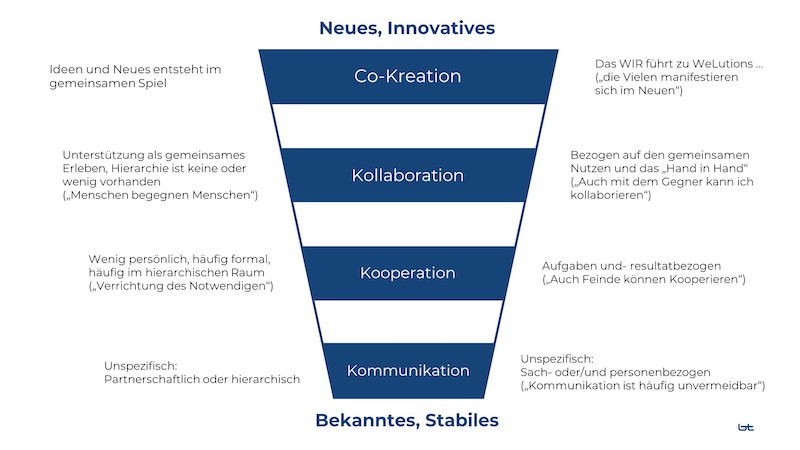Virtual collaboration is our daily bread at the moment: we all spend a lot of time in online meetings. And they are tough. So how can our virtual collaboration be better organized?
Online meeting marathon – the curse of the pandemic
Barbara sighs. Since the lockdown and working from home, she only attends online meetings. One after the other. Their fate seems sealed: In her calendar, web-co follows web-co; no change in sight.
Barbara is a manager at a machine parts manufacturer with around 300 employees. She is in charge of work preparation and is responsible for the clean coordination of production processes.
And it’s not just the sheer bombardment of online meetings that puts them under pressure; the dull ripple of endless meetings also exhausts them.
In most cases, many of the participants are unwilling or unable to switch on the camera. As a result, gray tiles talk to each other. Many of the meetings are nothing more than the good old telephone conference. Virtual collaboration my ass!
And when there are actually a few people around, she’s happy, but she gets dog-tired from staring at the screen for hours on end. As a manager, she has her camera on, so she can’t let it show. After all, the others watch her just as she watches what her visible colleagues do when they feel unobserved. Somehow you have to keep yourself awake at these anemic online events.
She finds it much easier to stare at the screen for long periods of time while watching a Netflix series. She’s happy to keep this up for a few hours longer. We all do, don’t we?
Efficiency in online meetings
Most of us are feeling like Barbara these days: one online meeting after another, none of them really efficient. The topics sound as exciting as “Talking through the sales results in QI for the EMEA region”. Most of the time it’s a guided PowerPoint reading: one person presents a full set of documents, there may be brief feedback and then the topic is changed again. Yawn.
There is no real exchange between them that could help them make progress. We are a long way from virtual collaboration. The participants are simply bombarded with information.
But Barbara doesn’t want to complain. After all, she often has to organize online meetings herself. She knows from experience that getting communication going online is really not easy. She is thinking about how she can make the joint digital meetings not only less tiring, but also much more efficient.
How can it manage to evolve from simple online communication towards cooperation, collaboration or even co-creation?
Our graphic shows you what the differences are:

The different levels of virtual collaboration
Cooperation in virtual collaboration
“Communication on the same page”
What should be the lowest common denominator?
Barbara greets the participants with a friendly smile; this is something that should not be neglected, especially in online meetings. Even before the meeting, she asked her colleagues to switch on the cameras this time so that everyone could see each other. This makes the meeting a lot more personal. And to make sure that everyone is talking about the same thing, it makes sense to illustrate the topic, be it flow charts or, if necessary, excel sheets.
It is important to Barbara that everyone is able to talk about the respective topic together, give feedback and that not just one person broadcasts and the others are condemned to listen. That works quite well.
Since in this case virtual communication is not just a one-way street, but also involves interaction, we can speak of cooperation – at a minimal level.
Barbara observes that these small changes have already brought a little more life into the WebCo: there has been feedback, a few new ideas have been incorporated and, above all, people have smiled at each other a few times. She is satisfied for today. But how can virtual collaboration be made more intensive and effective in future, as has often been the case with face-to-face events?

Collaboration in virtual collaboration
“Let’s work TOGETHER”
Barbara and her team have the task of developing a topic further together. In times before the pandemic and home office, everyone came together in the conference room armed with coffee, pens and sticky notes and worked happily together. It was always a special, creative atmosphere. We laughed, updated each other privately in the corridor and, above all, worked together constructively on the task.
The basis here was that no one lectured or told the others where to go, but that the colleagues pursued their common goal in a constant dialog at eye level.
She wants to achieve this hierarchy-free, appreciative collaboration online too.
It is therefore introducing an online collaboration tool. This allows all colleagues to work together on an online whiteboard, no matter where they are. The colleagues are delighted: they are happy to be able to do something, to learn to understand the tool with all its functions and to have escaped another uniform PowerPoint presentation. The team plays a little with the new possibilities, even messes around a bit and then gets started – with excellent results. And in the end, nobody is as tired as with the standard WebCos.
What happened here?
Collaboration has taken place. The difference to cooperation: Here, we work together at the same time instead of one after the other. Or to use an Anglicism: cooperation is work on the same page. Collaboration is work in the Same page at the Same moment. Barbara and her colleagues looked through documents together and made spontaneous corrections. They complemented each other in a joint process and made friendly contributions or contributed ideas for improvement.
What is collaboration good for?
Collaboration makes it possible to work towards a common goal on the same basis. For example, you can work out a new marketing plan with your team or develop a logo for a new project.
In our article Zoom Meeting & video conferencing: how it works, alternatives, tips, we explain the functions and differences between individual collaboration tools and give you all the tips on how to organize your online meeting perfectly. Technology, procedure, moderation, pipapo.

Co-creation in virtual collaboration
“Entering new spaces together”
The online collaboration between Barbara and her team has already worked extremely well on several occasions. Now they are facing a new virtual challenge: it is not just a question of working out solutions to a problem within a familiar framework; this time it is about developing something completely new in a creative process.
Because she and her team have often practiced non-hierarchical communication, lively cooperation and thinking outside the box in face-to-face meetings and now also online, they approach the task with enthusiasm. And because her team is diverse and can talk openly, many different thoughts and perspectives flow into the process. There is concentrated work, intense debate and lots of laughter. Barbara hadn’t expected so much success. Something really new is being created!
What is co-creation suitable for?
You also venture into new territory together in virtual collaboration. It is not about achieving a defined, concrete goal, but about being creative together. For example, you can use co-creation to develop a new value statement for your department or the entire company. Or create new customer access when personal access is only possible virtually in times of the pandemic.
Video Co-Creation Online
Christian Grätsch explains how you can successfully collaborate virtually.
Barbara is satisfied. With a few details, she has managed to revitalize the annoying WebCos and significantly improve the results.
The feedback from her team encourages her: at the end of the day, everyone prefers to work happily together.
Unfortunately, this kind of cooperation is not feasible for most companies, especially in the virtual space: In the usual, hierarchy-soaked web conferences in which one person puts colleagues to sleep with PowerPoint and Excel spreadsheets while they doze off with the cameras switched off, this is hopeless…
Which doesn’t mean that you can’t do it differently.
Our practical tips
How can you make virtual collaboration more effective, entertaining and personal?
1. ensure a hierarchy-free environment with interested and willing people!
2. ensure great diversity in the group of collaborators (age, gender, experience, technical and methodological know-how and perspectives on the subject area to be addressed)
3. give space and time for personal acquaintance and human encounters!
4. ensure that ALL participants have suitable technical equipment!
You can find details in our article Zoom Meeting & video conferencing: how it works, alternatives, tips….
5. empower and encourage participants to use and enjoy the virtual tool of co-creation!
6. give structure, time and a framework that allows sufficient freedom of thought, but keeps joint thinking and communication on track:
- Shorter, well-structured workshop sessions with breaks (2-4 hour sessions, spread over several days).
- Clear methodology, for example according to design sprint formats.
- Agile methods to balance focus and interpersonal encounters as a meaningful part of the process.
7. use the full possibilities of digital collaboration to enable real co-creation: Computers with camera and sound, web conferencing with breakout sessions, moderation white boards to work on and create things together simultaneously and lively.
8. take care of a moderation that creates joy, courage and pleasure in working together and, in addition to the content, also takes up and moderates the interpersonal dynamics.
Working from home and in the office? – How does that work together?
Hybrid working – teamwork between home office & office: is it possible?
You want to deal with WebCos in detail? We have something for you: in our article Zoom Meeting & video conferencing: how it works, alternatives, tips you will find everything you need to know on the subject.













